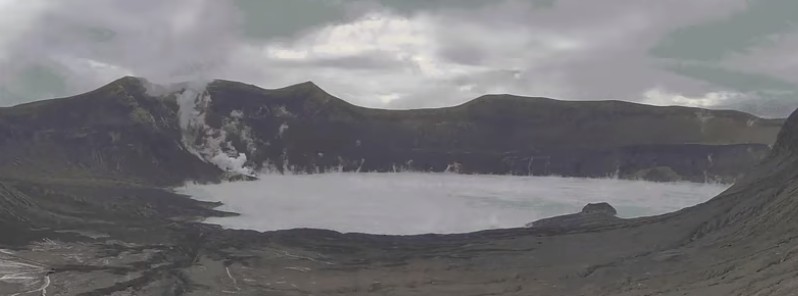Persistent magmatic activity at shallow depths beneath Taal volcano, Philippines

In 24 hours to 00:00 UTC on April 14, the Taal Volcano Network recorded 383 volcanic earthquakes, including 238 episodes of volcanic tremor with durations of 1 to 12 minutes, 143 low-frequency volcanic earthquakes, and low-level background tremor that started at 01:05 UTC on April 8, 2021.
Upwelling of hot volcanic fluids in the Main Crater lake occurred on April 13, generating 300 m (984 feet) tall steam-laden plumes from active fumaroles on the northern side.
Sulfur dioxide (SO2) emission averaged 1 886 tonnes/day on April 12, 2021.
Temperature highs of 71.8 °C (161 °F) and pH of 1.59 were last measured from the Main Crater Lake respectively on March 4 and February 12, 2021.
Ground deformation parameters from electronic tilt, continuous GPS, and InSAR monitoring continue to record very slow and steady inflation and expansion of the Taal region that began after the January 2020 eruption.
These parameters indicate persistent magmatic activity at shallow depths beneath the edifice.
The volcano remains at Alert Level 2 (Increased Unrest).
At this level, sudden steam-driven or phreatic explosions, volcanic earthquakes, minor ashfall, and lethal accumulations or expulsions of volcanic gas can occur and threaten areas within and around Taal Volcano Island (TVI).
DOST-PHIVOLCS strongly recommends that entry must be strictly prohibited into TVI, Taal’s Permanent Danger Zone or PDZ, especially the vicinities of the Main Crater and the Daang Kastila fissure, and occupancy and boating on Taal Lake. Local government units are advised to continuously assess and strengthen the preparedness of previously evacuated barangays around Taal Lake in case of renewed unrest.
Geological summary
Taal is one of the most active volcanoes in the Philippines and has produced some of its most powerful historical eruptions. Though not topographically prominent, its prehistorical eruptions have greatly changed the topography of SW Luzon.
The 15 x 20 km (9 x 12 feet) Talisay (Taal) caldera is largely filled by Lake Taal, whose 267 km2 (103 mi2) surface lies only 3 m (9.8 feet) above sea level.
The maximum depth of the lake is 160 m (525 feet), and several eruptive centers lie submerged beneath the lake. The 5 km (3.1 miles) wide Volcano Island in north-central Lake Taal is the location of all historical eruptions.
The island is composed of coalescing small stratovolcanoes, tuff rings, and scoria cones that have grown about 25% in the area during historical time. Powerful pyroclastic flows and surges from historical eruptions have caused many fatalities. (GVP)
Featured image: Steaming at Taal volcano on April 13, 2021. Credit: PHIVOLCS

Commenting rules and guidelines
We value the thoughts and opinions of our readers and welcome healthy discussions on our website. In order to maintain a respectful and positive community, we ask that all commenters follow these rules.